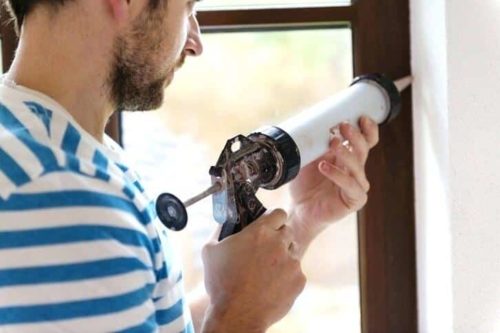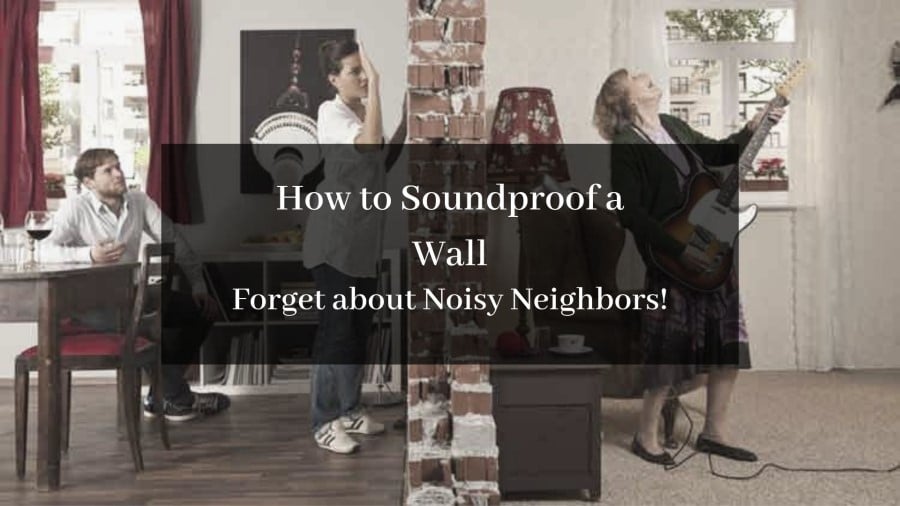So, you live in one of those modern apartments which look great but lack acoustic insulation, meaning that you can hear and even understand what your neighbors are saying.
The shared walls, also known as party walls, in these kinds of apartments tend to be thin and hollow, and sound has a very easy time getting through.
This is something that always bugged me, but luckily there are some ways for you to fix this issue which I’m going to discuss in this article.
Table of Contents
How to Soundproof a Wall
The most effective way of soundproofing an existing wall is by installing drywall with a special noiseproofing compound behind it and caulking the gaps left between the drywall sheets.
Using acoustic blankets, or any other sound absorbing materials, will help but just slightly and the difference won’t be that noticeable.
Soundproofing vs Sound Absorption
Soundproofing is the process of isolating or blocking the sound, not allowing it to enter or to leave a room.
To do this you will need to use materials that are designed to not let sound through, like mass loaded vinyl, drywall, etc.
Sound Absorption relies on materials that are good at absorbing sound, such as acoustic panels, acoustic blankets, etc. to reduce the echo inside of a room.
Sound absorption, while not being great at soundproofing, will still help with it, which is why you might want to use it in conjunction with sound-blocking materials to achieve the best results.
You can learn more about the differences between soundproofing and acoustic treatment here.
Now, let’s get into the guide.
Install an extra layer of Drywall

Installing drywall will do two things; Block airborne noise and reduce structural vibration transmission, and if you have a seriously thin wall, then investing in drywall might be the best solution.
However, doing this can be expensive, especially because you would also need to invest in a noiseproofing compound, acoustic caulk, and probably in hiring someone to install it for you as well.
Best Practices for installing drywall
Apply a Noiseproofing Compound
Before installing the Drywall make sure to apply a generous amount of this Green Glue Noiseproofing Compound (link to Amazon) behind the drywall sheets.
You don’t need to worry about the pattern or how you apply it, simply make sure that it’s evenly distributed.
This Noiseproofing Compound will further reduce sound transmission, so don’t skip it!
Apply Acoustic Caulk

Once the drywall sheets are in place, it’s time to seal the gaps left between those sheets with this Acoustic Caulk (link to Amazon).
Apply the caulk using a caulk gun and make sure to seal everything as well as you possibly can for better insulation.
If you want to take things even further, then here’s a more effective recommendation than just installing the drywall on its own;
Install the Drywall with the Mass Loaded Vinyl
If your walls are really THAT thin that you can hear anything and everything your neighbors do, then combining the two methods will ensure that you never hear them again.
First install the MLV and then the drywall on top of it.
The Noiseproofing Compound and the Acoustic Caulk should still be used both on the MLV and the Dywall.
Install Noiseproofing Panels
Noiseproofing panels are another alternative to installing drywall, but these are specifically designed to absorb sound.
Noisestopsystems sell a Wall System made of a combination of products which give the highest noise reduction possible.
It’s designed to add mass, absorption and separation to your walls, which will ensure that not only airborne noise is reduced, but also the vibrations transmitted.
It is especially good for loud voices and music, which is the typical noise in most apartment situations.
Treat Flanking noises
The methods described above work at reducing the direct sound paths, which basically means lowering the amount of noise allowed through the wall directly.
The issue is that in most cases the walls are just part of the problem.
Flanking noise reduction is a lot harder to treat as flanking noise transmission is basically any other path that the sound will take to travel through the structure.
This can be through the ceiling, floor, roof structures, service penetrations, air-vents, you name it!
Treating flanking noise in an already existing building is tough because sound is transferred from one structure to another, especially if they are connected, but there are a couple things you can do.
What are the major Flanking Paths and how to fix them?
There are some common noise pathways which should be considered in order to know where to soundproof;
Floor Framing System
In some constructions there is a joist system that travels under the wall and these floor systems are connected on both sides of the wall.
This means that even though there is no air path for sound to be transmitted, the vibrations generated on one side can easily reach the other side.
Sadly, there isn’t that much you can do other than installing a floor underlayment and a floating floor on top of it.
You could also try Interlocking floor mats like these ones available on Amazon which are super affordable, just make sure to get enough of them to cover the entirety of the room’s floor.
Ceiling Joist System
A similar thing happens with the ceiling since in some cases an attic may be common to both rooms and the noise and vibrations generated in one can easily be transmitted to the next.
The simplest way is to install drywall on the ceiling which should add a bit of insulation, but the vibrations will still be transmitted.
To do this more effectively I’d recommend purchasing sound insulation clips which will help decouple the drywall from the ceiling.
Decoupling in soundproofing involves separating the framing in the ceiling to break the sound pathway, essentially reducing the noise.
Side Walls
This is by far the most common flanking path since the walls are directly connected to one another, which means that sound and vibrations can easily be transmitted through them.
In order to fix this, you will need to soundproof your existing walls which can be done just like I explained earlier, with Drywall, Mass Loaded Vinyl, etc.
Air Vents
Air Vents are excellent at propagating noise for the simple fact that they are a hollow piece of metal connecting different spaces.
You have two easy ways to reduce this kind of noise;
Hang Sound Dampening Materials in front of the Vent
Using sound absorbing materials like acoustic curtains or blankets and hanging them in front of the air vent will decrease the amount of noise allowed into the room.
This is the simplest solution, even though some sound will still be able to get through.
Make a Sound Maze inside the Vent
This one is a bit trickier to accomplish, but it certainly does work.
Sound likes travelling in a straight line, as soon as you build a maze out of sound absorbing materials, like acoustic foam, for it to navigate before it can reach the room, the level of noise that ends up getting in will be drastically lower.
It should look something like this;

Doors
Most doors, especially the new ones which you can find in most modern apartments, are hollow inside or barely filled with some Styrofoam.
This can help with thermal insulation, but not with blocking sound.
Flanking noise can also enter through the door and much more than you’d think, so make sure to properly soundproof the door in order to reduce this.
I’ve written a complete guide on how to Soundproof a Door which should be of great use.
Electrical Outlets
You might be wondering why I’m even mentioning this, since one wouldn’t immediately think of outlets being the culprit of poor sound insulation, but they definitely can let noises in- or out and without much difficulty either.
The good news is that they are very easy to insulate, and in an affordable way also!
Steps to Soundproofing an Electrical Outlet
- Use an Outlet Seal: These rubber seals go between the plate and the electrical box and will prevent both sound and air-drafts.
- Acoustic Putty: Acoustic Putty can be used to soundproof odd shapes, such as electrical boxes.
- Use Acoustic Caulk: You could also use acoustic caulk between the plate and the electrical box/wall to create a righter seal.
Another alternative would be to get a weatherproof electrical outlet cover, but this could interfere with the aesthetics of the kitchen.
Extra Tips for soundproofing a Shared Wall
Here are a couple extra steps that you can take which don’t involve spending as much and also don’t take up as much of your time;
Use Furniture to your advantage
If you have a big bookcase which you can put against the offending wall, then you should do so.
Bookcases are great at blocking sound because they are made of solid wood, plus filling it up with books can only help.
Install sound absorbing materials
Sound absorbing/deadening materials don’t block sound as much as something like Mass Loaded Vinyl, but they still help reduce the overall level of noise that is allowed in through the wall.
Investing in these BA Series 9 panels can certainly help reduce the noise transmission through the wall.
They don’t block the sound entirely but they will help reduce it a bit, making them ideal for soundproofing a wall that doesn’t need as much insulation.
Regular acoustic panels work the same way, plus they absorb the soundwaves that bounce off the walls inside your apartment, making it feel more silent in general.
If you find both of these options to be too expensive, then you should consider acoustic blankets.
These are extremely cheap and effective and I’d recommend this pack of 12 blankets from Amazon.
Acoustic blankets are one of my favorite sound deadening items mainly because of how versatile they are, plus they are dead cheap!
Lastly you may want to get a thick carpet and place it right in front of the door. This is a good way to at least absorb some of the flanking noise which might enter through the bottom of the door.
Conclusion
Soundproofing an already existing wall isn’t as easy as soundproofing a door or a window, but it is definitely doable.
Installing an extra layer of drywall may be the best choice considering both the cost and how easy it is to do, since you can do it yourself.
If you have the budget and the skill you might want to install the Mass Loaded Vinyl WITH the drywall for added benefits.
Otherwise you might want to give the noiseproofing panels a try, but those are a bit more expensive.
If the noise your neighbors make isn’t completely unbearable and you simply want it a bit lower, then consider the extra steps I described.
If you have any other tips on how to soundproof a wall that I didn’t mention please leave a comment below!
Have a wonderful day!
Last Updated on May 11, 2022 by Facundo
